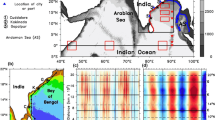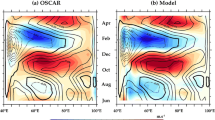Abstract
The characteristics and variability of the East India Coastal Current (EICC), the western boundary current in the Bay of Bengal (BoB) during the Indian Ocean Dipole (IOD) years between 2006 and 2012 have been investigated using the high-resolution Regional Ocean Modeling System (ROMS). The evolution of temperature, mixed layer depth (MLD), and seasonal basin scale circulation in the upper ocean simulated by the model agrees well with the observations. The EICC in BoB is characterized by a seasonal reversal flow: the poleward EICC during February−May and the equatorward EICC during August−December. A long-term simulation from 2006 to 2012 suggest that the circulation pattern, boundary current structure, and transport in the western BoB are completely different in positive and negative IOD years. As IOD is mainly phase-locked to the seasonal cycle with most significant influence in the Borel autumn, the equatorward EICC is affected during the IOD years. It is found that the strength of this EICC is ~ 5 Sv in October 2010 and a weaker EICC dominated by the presence of eddies is observed in October 2006. We also quantified the local and remote forcing effects on the variability of EICC and found that the seasonal coastal Kelvin waves (KWs) play a dominant role in the development of the EICC. During positive IOD year 2006, due the absence of second downwelling KW, the EICC is completely disorganized and dominated by the eddies, whereas in the negative IOD year 2010, the strong second downwelling KW plays a key role in developing organized and stable EICC in the western BoB.











Similar content being viewed by others
References
Aparna SG, McCreary JP, Shankar D, Vinayachandran PN (2012) Signatures of Indian Ocean dipole/zonal mode and El Niño southern oscillation events in sea-level variations in the bay of Bengal. J Geophys Res 117:C10012. https://doi.org/10.1029/2012JC008055
Babu MT, Prasanna Kumar S, Rao DP (1991) A sub-surface cyclonic eddy in the bay of Bengal. J Mar Res 49:404–410
Babu MT, Sarma YVB, Murty VSN, Vethamony P (2003) On the circulation in the bay of Bengal during northern spring inter-monsoon (March–April 1987). Deep-Sea Res II 50:855–865
Chakraborty A, Gangopadhyay A (2015) Development of a high-resolution multiscale modelling and prediction system for the bay of Bengal. Part I: climatology based simulation. Open J Mar Sci 06(01):145–176
Chakraborty A, Gangopadhyay A (2016) Development of a high-resolution multiscale modelling and prediction system for the bay of Bengal. Part II: an application to October 2008. Open J Mar Sci 06(01):125–144
Dandapat S, Chakraborty A (2016) Mesoscale eddies in the Western Bay of Bengal as observed from satellite altimetry in 1993–2014: statistical characteristics, variability and three-dimensional properties. IEEE J Sel Top Appl Earth Obs Remote Sens 9(11):5044–5054
Dai A, Trenberth KE (2002) Estimates of freshwater discharge from continents: latitudinal and seasonal variations. J Hydrometeorol 3:660–687
Di Lorenzo E, Miller AJ, Neilson DJ, Cornuelle BD, Moisan JR (2004) Modeling observed California current mesoscale eddies and the ecosystem response. Int J Remote Sensing 25(7):1307–1312
Duacs/AVISO (2014) A new version of SSALTO/Duacs products available in April 2014. CNES [http://www.aviso.altimetry.fr/fileadmin/documents/data/duacs/Duacs2014.pdf.], Version 1.1
Durand F, Shankar D, Birol F, Shenoi SSC (2008) Estimating boundary currents from satellite altimetry: a case study for the east coast of India. J Oceanography 64(6):831–845
Durand F, Shankar D, Birol F, Shenoi SSC (2009) Spatio-temporal structure of the East India coastal current from satellite altimetry. J Geophys Res 114(2):18
Gangopadhyay A, Bharat Raj GN, Chaudhuri AH, Babu MT, Sengupta D (2013) On the nature of meandering of the springtime western boundary current in the bay of Bengal. Geophys Res Lett 40:2188–2193
Han W, Moore AM, Levin J, Zhang B, Arango HG, Curchitser E, Lorenzo ED, Gordone AL, Linf J (2009) Seasonal surface ocean circulation and dynamics in the Philippine archipelago region during 2004–2008. Dyn Atmos Oceans 47:114–137
Han W, Webster PJ (2002) Forcing mechanisms of sea-level interannual variability in the bay of Bengal. J Phys Oceanogr 23:216–239
Haidvogel DB, Arango H, Hedstrom K, Beckman A, Malanotte-Rizzoli P, Shchepetkin AF (2000) Model evaluation experiments in the North Atlantic basin: simulations in nonlinear terrain following coordinates. Dyn Atmos Oceans 32:239–281
Jana S, Gangopadhyay A, Chakraborty A (2015) Impact of seasonal river input on the bay of Bengal simulation. Cont Shelf Res 104:45–62
Malanotte-Rizzoli P, Hedstrom K, Arango HG, Haidvogel DB (2000) Water mass pathways between the subtropical and tropical ocean in a climatological simulation of the North Atlantic Ocean circulation. Dyn Atmos Oceans 32:331–371
McCreary JP, Han W, Shankar D, Shetye SR (1996) Dynamics of the East India coastal current. Numerical solutions. J Geophys Res 101(C6):13993–14000
McPhaden MJ (2004) Evolution of the 2002/03 El Ni~no. Bull Am Meteorol Soc 85:677–695
Murtugudde R, McCreary JP, Busalacchi J (2000) Oceanic processes associated with anomalous events in the Indian Ocean with relevance to 1997–1998. J Geophys Res 105:3295–3306
Penven P, Roy C, Lutjeharms JRE, Colin de Verdiere A, Johnson A, Shillington F, Freon P, Brundrit G (2001) A regional hydrodynamic model of the southern Benguela. S Afr J Sci 97:472–476
Potemra JT, Luther ME, O’Brien JJ (1991) The seasonal circulation of the upper ocean in the bay of Bengal. J Geophys Res 96:12667–12683
Rao RR, Girish Kumar MS, Ravichandran M, Rao AR, Gopalakrishna VV, Thadathil P (2010) Interannual variability of kelvin wave propagation in the wave guides of the equatorial Indian Ocean, the coastal bay of Bengal and the southeastern Arabian Sea during 1993–2006. Deep-Sea Res I 57:1–13
Saji NH, Goswami BN, Vinayachandran PN, Yamagata T (1999) A dipole mode in the tropical Indian Ocean. Nature 401:360–363
Sanilkumar KV, Kuruvilla TV, Jogendranatht D, Rao RR (1997) Observations of the western boundary current of the bay of Bengal from a hydrographic survey during March 1993. Deep-Sea Res I 44:135–145
Shankar D, McCreary JP, Han W, Shetye SR (1996) Dynamics of the East India coastal current. 1. Analytic solutions forced by interior Ekman pumping and local alongshore winds. J Geophys Res 101(C6):13975–13991
Shankar D (2000) Seasonal cycle of sea level and currents along the coast of India. Curr Sci 78(3):279–288
Shchepetkin A, McWilliams J (2005) The regional oceanic modeling system (ROMS): a split-explicit, free-surface, topography following-coordinate oceanic model. Ocean Modell 9:347–404
Shetye SR, Gouveia AD, Shenoi SSC, Sundar D, Michael GS, Nampoothori G (1993) The western boundary current of the seasonal subtropical gyre in the bay of Bengal. J Geophys Res 98:945–954. https://doi.org/10.1029/92JC02070
Shetye S, Gouveia A, Shankar D, Shenoi SSC, Vinayachandran P, Sundar D, Michael G, Nampoothiri G (1996) Hydrography and circulation in the western bay of Bengal during the northeast monsoon. J Geophys Res 101: 114011–14025. doi:https://doi.org/10.1029/95JC03307, 14011
Sil S, Chakraborty A, Ravichandran M (2010) Numerical simulation of surface circulation features over the bay of Bengal using Regional Ocean modeling system. Adv Geosci 24:117–128
Sil S, Chakraborty A (2011) Simulation of East India coastal features and validation with satellite altimetry and drifter climatology. Ocean Clim Syst 2(4):279–289
Sreenivas P, Gnanaseelan C, Prasad KVSR (2012) Influence of El Niño and Indian Ocean Dipole on sea level variability in the Bay of Bengal. Glob Planet Chang 80–81:215–225
Srinivas K, Kumar PKD, Revichandran C (2005) ENSO signature in the sea level along the coastline of the Indian subcontinent. Indian J Mar Sci 34:225–236
Stevens DP (1990) On open boundary conditions for three dimensional primitive equation ocean circulation models. Geophys Astrophys Fl Dyn 51:103–133
Warner JC, Sherwood CR, Arango HG, Signell RP (2005) Performance of four turbulence closure methods implemented using a generic length scale method. Ocean Model 8:81–113
Vinayachandran PN, Shetye SR, Sengupta D, Gadgil S (1996) Forcing mechanism of the bay of Bengal circulation. Curr Sci 71:753–763
Vinayachandran PN, Kurian J, Neema CP (2007) Indian ocean response to anomalous conditions during 2006. Geophys Res Lett 34:L15602. https://doi.org/10.1029/2007GL030194
Yamagata T, Behera SK, Luo J-J, Masson S, Jury M, Rao SA (2004) Coupled ocean–atmosphere variability in the tropical Indian Ocean. AGU Earth Clim 147:189–212
Acknowledgments
The authors gratefully acknowledge http://www.myroms.org for providing online access of the ocean model ROMS. We have obtained wind, net heat flux, evaporation, and precipitation data from ECMWF Era-Interim. The temperature and salinity data required for model initialization are downloaded from MERCATOR Ocean Model. The satellite altimeter products used here were provided by Ssalto/Duacs and distributed by AVISO (ftp://ftp.aviso.oceanobs.com/), with support from CNES. DMI indices are available at http://www.jamstec.go.jp/frcgc/research/d1/iod/sstdmi.weekly.ascii. The ONI index is available at NOAA Climate pacific Center (http://www.cpc.ncep.noaa.gov/). The authors are thankful to the Indian Institute of Technology Kharagpur, India, for providing research fellowship and necessary facilities through MHRD for carrying out this research work. We would also like to thank for the financial support given by Indian National Centre for Ocean Information Services (INCOIS), SRIC/CMI project of IIT Kharagpur, and Ministry of Earth Sciences, Government of India, to conduct this research.
Author information
Authors and Affiliations
Corresponding author
Additional information
Responsible Editor: Anthony C Hirst
Rights and permissions
About this article
Cite this article
Dandapat, S., Chakraborty, A. & Kuttippurath, J. Interannual variability and characteristics of the East India Coastal Current associated with Indian Ocean Dipole events using a high resolution regional ocean model. Ocean Dynamics 68, 1321–1334 (2018). https://doi.org/10.1007/s10236-018-1201-5
Received:
Accepted:
Published:
Issue Date:
DOI: https://doi.org/10.1007/s10236-018-1201-5




